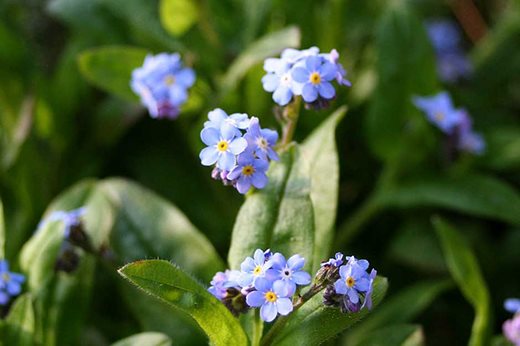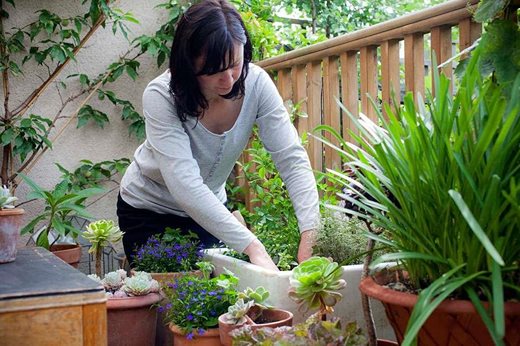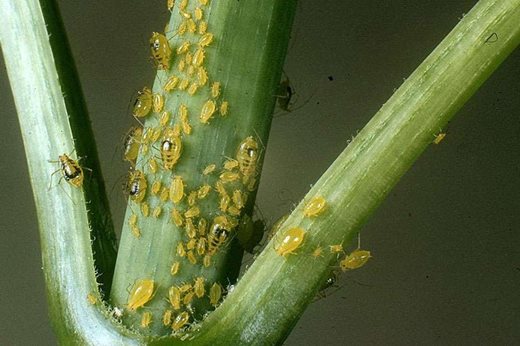Sowing
 Hardy annuals can be sown in pots or modules to provide colour in the garden. Annual grasses can be fun to try too: Briza maxima (right), Lagurus ovatus and Hordeum jubatum are suitable examples. In mild areas with light soil, you can sow directly outside by marking out irregularly shaped seedbeds and broadcasting ‘drifts’ of different seed to give a more natural look.
Hardy annuals can be sown in pots or modules to provide colour in the garden. Annual grasses can be fun to try too: Briza maxima (right), Lagurus ovatus and Hordeum jubatum are suitable examples. In mild areas with light soil, you can sow directly outside by marking out irregularly shaped seedbeds and broadcasting ‘drifts’ of different seed to give a more natural look.
Modular trays are useful for sowing half-hardy summer bedding plants such as marigolds (Tagetes), Lobelia, and Petunia. Label each seed tray. You will need to sow them under cover, or in a heated propagator, at the correct temperature, only putting them outside when the weather is reliably warm day and night.
Sweet peas can be sown outside this month. Plant out autumn-sown sweet peas that have been raised in pots, and prepare your wigwam supports for them to climb, using a light twine to tie the plants in.
If you started sowing early in March, or even February, you may have modules of young hardy annuals now ready for planting out.
Planting and potting
 Towards the end of the month, in mild areas, you may be able to plant up hanging baskets for the summer. When planting hanging baskets use slow-release fertiliser and water-retaining gel.
Towards the end of the month, in mild areas, you may be able to plant up hanging baskets for the summer. When planting hanging baskets use slow-release fertiliser and water-retaining gel.
When space becomes available in the greenhouse, pot up cuttings of tender perennials taken last summer and at the beginning of this year. You can bulk up plant numbers by taking more cuttings from the largest of the new plants.
Plant summer-flowering bulbs, if not done already. Prepare the soil first, to ensure that drainage is sufficient to prevent the bulbs rotting. Anemone coronaria tubers, for instance, need particularly well-drained soils.
You can still plant herbaceous perennials such as Geranium, Astrantia and oriental poppies. Check that the plants you buy have strong, green shoots and plant them into well-prepared soil.
Plan a continuous crop of cut flowers for this summer. Perennials such as delphiniums and annuals can be grown to produce a useful and beautiful display.
Cutting back, pruning and dividing
_PUB0008696_1.jpg?width=520&height=346) Prune penstemons and other slightly tender plants such as Teucrium and lavender. Make the cuts just above fresh, new shoots.
Prune penstemons and other slightly tender plants such as Teucrium and lavender. Make the cuts just above fresh, new shoots.
When pruning perennials some plants benefit from having their flowering shoots thinned out. Although this results in fewer blooms, they are larger and of better quality. Delphiniums, lupins and phlox all benefit from this process.
Divide herbaceous perennials when they are too large for their allotted space, are flowering poorly or have lost their shape. Bamboos and clumps of bulbs or rhizomes can be divided in the same way. When transplanting the divisions make sure they have roots, shoots, and are given adequate water to settle into their new positions.
Perennials that are showing new shoots from the crown can be propagated via basal stem cuttings. Shoots 8-10cm (3-4in) high are cut from the parent plant with a sharp knife. Sometimes a piece of root can be taken with the cutting (which speeds establishment), but stems can be cut without root, and then dipped in hormone rooting powder before striking into growing medium, as for softwood cuttings.
General maintenance
 Put supports in place for perennials before they get too large. Criss-crossing strings from hidden or decorative posts work well, allowing stems to grow up in the gaps between strings.
Put supports in place for perennials before they get too large. Criss-crossing strings from hidden or decorative posts work well, allowing stems to grow up in the gaps between strings.
Apply a general-purpose fertiliser to borders and beds. Take care not to damage emerging shoots, or to burn them with fertiliser.
Top dress spring-flowering alpines with grit or gravel to show off the plants and to help prevent stem rots.
Bulbs coming up in the rock garden or in containers may benefit from overhead protection from the rain - a sheet of glass or perspex placed on bricks will do the job.
Remove faded daffodil and tulip flowers, nipping off the heads and seed pod at the same time.
Deadhead pansies, primulas and other spring bedding plants. Pansies will carry on into the spring and even to early summer, if attended to frequently.
Cleaning up
 It is now time to remove tired winter bedding and plants that did not survive the winter.
It is now time to remove tired winter bedding and plants that did not survive the winter.
Check that self-seeded forget-me-nots aren’t smothering other border plants. Pull out plants if necessary.
Hoe borders to prevent annual and perennial weeds from spreading and seeding themselves.
Herbaceous perennials infested with couch grass and other perennial weeds should be lifted so the roots of the weeds can be removed.
Any mulches may need replacing after weed removal.
 You could plant up an alpine trough to display some of your alpine plants as many can look their best at this time of year.
You could plant up an alpine trough to display some of your alpine plants as many can look their best at this time of year.
Check whether containers need watering. Even at this time of year, they can dry out.
Pots and tubs benefit from topping up with fresh compost. Old compost can be removed and replaced with new to a depth of 5cm (2in) if there is not much room for topping up.
Pot on plants showing signs of being pot-bound. You can tip out the root balls of unhappy looking containers, to see if they are pot-bound or if they are suffering from some other problem.
Pest and disease watch
 Aphids (left) can multiply rapidly during mild spells. Remove early infestations by hand to prevent the problem getting out of hand. Protect sweet pea plants in particular, as they can get sweet pea viruses.
Aphids (left) can multiply rapidly during mild spells. Remove early infestations by hand to prevent the problem getting out of hand. Protect sweet pea plants in particular, as they can get sweet pea viruses.
Continue to protect lilies, delphiniums, hostas and other new shoots from slugs and snails.
Damage to plant roots by vine weevil larvae shows by the plants starting to wilt. On inspection the roots will have been badly eaten, and you may see the white C shaped larvae among them. Apply biological control if larvae are present, but young and containerised plants are unlikely to recover once badly damaged.
Watch out for downy mildew and black leaf spot on winter pansies. Remove any affected leaves and destroy badly affected plants.
Remove dead leaves from around the basal rosettes of alpine plants to prevent rotting.

